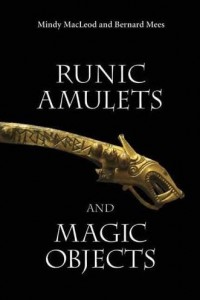 Runic Amulets and Magic Objects by Mindy MacLeod and Bernard Mees
Runic Amulets and Magic Objects by Mindy MacLeod and Bernard Mees
2006, The Boydell Press
278 pages
This book is essential reading for anyone interested in runes or indeed European cultural history. Macleod and Mees decline to adopt the recent fashion in academic circles for dismissing the idea that the runes had any kind of magical significance, just as they refuse to prete0nd that different regions were hermetically sealed from one another. They steer a balanced path between emphasising the many mundane applications of the runes and their magical function, and indeed the book focuses on the latter, as may be inferred from the title.
The authors document and interpret scores of inscriptions from amulets, artefacts, monuments, and written texts, bringing incredible breadth and depth of learning to the task. Their vibrant enthusiasm for the subject matter is infectious, and consequently the book is anything but dry or boring. Indeed, there are even moments of high humour, such as a hilarious passage that recounts some of the more ribald love magic charms of the runic era!
The interpretations and explanations of the inscriptions are fleshed out with background perspective on cultural history and a real empathy for folk long dead, and this make the book much more than just a study of dusty museum pieces to be nit-picked and quarrelled over. The endlessly unfolding cultural and political evolution of Northern Europe over the centuries is explored through the angular scratchings of the runes, and the reality of Europe’s convoluted history is graphically exposed in the inscriptions that remain.
One of the most striking things that emerges from this book is the incredible diversity of runic writings. Although we talk about, say, “the Elder Futhark” as though it were a defined and uniform 24 character alphabet, the reality is that rune carvers modified the characters ceaselessly, obeying all manner of personal whims as to the orientation, style, and variety of ways of carving the runes. There is an almost aggressive outpouring of creative invention in the way that the rune carvers improvised on the basic themes of these archaic characters, a phenomena that we in our age of standardised spelling and formatting might struggle to grasp.
The book goes deep into the patterns and structures by which magical runic inscriptions on charms and amulets were composed. Indeed, their analysis of the five-fold structure of these inscriptions is elegant and brilliant, as is their discussion o the significance of terms like “alu.” Anyone interested in making their own modern rune carvings would benefit greatly from this book, which inadvertently serves as a detailed and clear “how to” manual.
In the course this analysis of the structure of runic amulet inscriptions the authors also underscore how indebted the Germanic runic tradition was to the Etruscans – for the fundamental magical structure used in the rune inscriptions was adopted wholesale from Etruscan/Rhaetic traditions. This is a fine illustration of the point that cultural exchange and mixing can sometimes strengthen the cultures involved and help them become more unique and distinct: this non-Germanic influence surely seeded one of the most distinctive aspects of Germanic culture. The tendency of some academics to only focus on specific regions (say, England) therefore risks grossly distorting our understanding of both history and the runes.
The book also makes the point that the runes were heavily used for Christian as well as Heathen purposes in later centuries, that they were combined with various other magical traditions, sometimes quite elegantly and even seamlessly, though it is clear that their place as a magical tool eroded by the middle ages and their usage became progressively more trivialised. This in turn underscores the complex cultural dynamics unleashed by the coming of Christianity, and the durability of Heathen cultural practices and aesthetics post-conversion, although the magical tradition of the runes seems to have ultimately declined into ignorance and ignominy.
The authors express some very valid criticisms of the use of the Icelandic sagas as sources for understanding rune lore, but their analysis of the Eddic poems “Havamal” and “Sigrdrifumal” concludes that these sources do provide valuable insights for understanding rune magic, again making the point that in the past some academics have been perhaps sceptical of these sources to an unjustifiable extent. This is very useful information, particularly as the mistake of seeing the sagas as a faithful representation of Dark Age Scandinavian culture seems very common.
I find myself disagreeing with the authors’ view that the various rune poems were merely mnemonics for remembering the rune alphabet orders, however. From personal experience I can assure the reader that memorising these poems for the most part) is far more arduous than merely memorising the Futhark alphabet(s) – indeed, I have forgotten my verbatim memory of the poems (though the substance remains), but remembering the correct Futhark order is easy and was, I found, almost a prerequisite for being able to absorb the rune poems into memory. An intelligent young child could happily memorise the rune names and order, but almost certainly not the poems.
Furthermore, the poems themselves seem to echo many aspects of Heathen culture and worldview and paint incredibly evocative images that, at least in my opinion, resonate much further than any putative modern mnemonic equivalent (“the quick brown fox jumps over the lazy dog” comes to mind). There are various other criticisms that could be made of the book, too, although ultimately it survives its flaws admirably.
On the whole this book is a revelatory window into the free-wheeling, anarchic, and bracing world of rune magic as attested by primary sources (as opposed to wishful thinking in either too-fanciful or too-cynical directions). It is fun, fascinating, and inspiring, and strongly, strongly recommended. The price tag is rather high, and this may dissuade some from making the purchase – but please, take the plunge, Runic Amulets and Magic Objects is worth every penny.









Leave a Reply